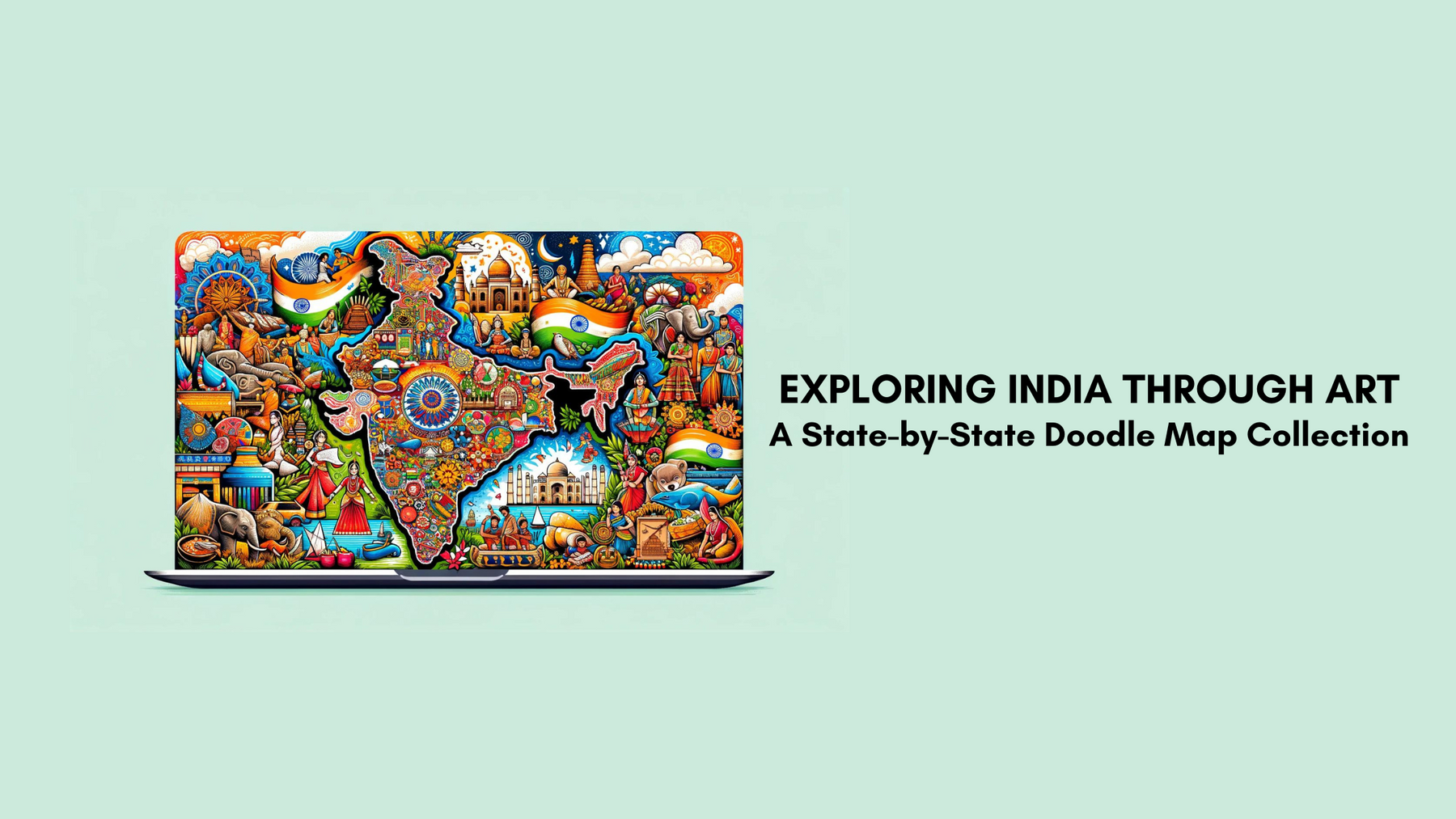on all orders

Exploring India Through Art: A State-by-State Doodle Map Collection
Step into the vibrant world of India as you embark on a visual journey through its diverse states, each depicted in a unique and captivating doodle map. From the snow-capped peaks of the Himalayas to the serene backwaters of Kerala, these artistic renditions offer a glimpse into the rich tapestry of India's cultural and geographical heritage. You'll be intrigued to discover how these doodle maps not only showcase the beauty of each state but also unravel the stories and traditions that have shaped India's identity.
Overview of India's rich cultural and geographical diversity.
India's vast and diverse cultural tapestry, coupled with its varied geographical features, makes it a captivating and multifaceted country to explore. The cultural heritage of India is as diverse as its geographic landscape, with each region boasting its own unique traditions and artistic representation. From the snow-capped peaks of the Himalayas to the sun-kissed beaches of the south, India's geographic diversity is reflected in its traditional crafts and historical landmarks.
The country's rich cultural heritage is evident in its artistic representation, ranging from intricate dance forms like Bharatanatyam in the south to the vibrant folk art of Madhubani in the east. Each state in India has its own traditional crafts that are reflective of its cultural ethos, such as the exquisite handloom sarees of Varanasi and the intricately carved wooden artifacts of Rajasthan.
Moreover, India's historical landmarks, such as the majestic forts of Rajasthan and the ancient temples of Tamil Nadu, offer a glimpse into the country's rich past. Exploring India through its art provides a unique opportunity to appreciate the interplay between cultural diversity and geographic richness, making it a truly enriching experience.
Introduction to the unique project by "Dudus Online" - creating doodle maps for each Indian state.
Dudus Online has embarked on a unique project to create doodle maps for each state in India, showcasing the cultural and geographical essence of the diverse regions. The artistic inspiration behind this endeavor stems from a deep appreciation for India's rich heritage and a desire to visually narrate the unique stories of each state through doodle mapping. Each state representation is carefully crafted to capture the essence of its distinct identity, offering a visually captivating avenue for Indian exploration.
The project goes beyond mere cartography, delving into the realm of visual storytelling. Through intricate details and vibrant imagery, the doodle maps serve as windows into the soul of each state, reflecting its history, traditions, landmarks, and natural beauty. By employing this creative medium, Dudus Online aims to offer a fresh perspective on India's cultural and geographical tapestry, inviting viewers to immerse themselves in the visual narrative of each state.
This innovative approach not only celebrates the diversity of India but also provides an engaging platform for individuals to connect with the country's multifaceted heritage on a deeper, more personal level.
The Artistic Vision
Crafting doodle maps for each state in India involves a creative fusion of art and cartography, encapsulating the essence of diverse cultural narratives in a visually engaging manner. The creative process behind these maps is a meticulous blend of education, art, and cultural representation. The artistic techniques employed in the doodle maps play a crucial role in capturing the essence of each state. From intricate line work to vibrant colors, the artistic vision aims to evoke a sense of place and heritage. Cultural symbolism is intricately woven into the designs, conveying the rich tapestry of traditions and history unique to each state. Inspiration sources vary, ranging from folk art to architectural marvels, each contributing to the visual storytelling of the maps. However, this artistic endeavor also presents its challenges. Balancing the representation of diverse cultural elements within the confined space of a map requires thoughtful consideration. Managing the intricacies of each state's narrative while maintaining a cohesive visual language across the collection presents an artistic challenge that the creators skillfully navigate.
A Journey Through the Maps
Embarking on a journey through the intricately crafted doodle maps of India reveals a captivating fusion of artistic expression and geographical representation. Each doodle map in the collection offers a unique lens through which to explore the cultural and geographical diversity of India. As you delve into this collection, you'll find that each state is depicted with distinct artistic representation, capturing the essence of its cultural heritage and natural beauty. The doodle maps invite you on a geographical journey, seamlessly blending art and cartography to provide a visually engaging experience.
Through this state-by-state exploration, you gain a deeper understanding of India's rich tapestry of traditions, languages, and landscapes. The doodle map collection serves as a gateway to cultural exploration, offering a glimpse into the heart of each region. You'll find yourself immersed in the vibrant hues and intricate details that bring each state to life on the canvas. This artistic approach to mapping not only navigates the geographical terrain but also invites you to appreciate the diversity and uniqueness of each state in a visually stimulating manner.
North India
How does the cultural tapestry of North India intertwine with its historical landmarks and natural beauty to create a unique regional identity? North India is a treasure trove of historical landmarks like the Golden Temple in Amritsar, the Taj Mahal in Agra, and the ancient temples of Varanasi. These sites not only showcase architectural brilliance but also hold immense historical significance. Traditional art forms in North India, such as Phulkari embroidery from Punjab and Pahari painting from Himachal Pradesh, reflect the region's rich artistic heritage. The region also hosts famous festivals like the vibrant Baisakhi in Punjab and the grand Kumbh Mela in Uttar Pradesh, which attract people from all over the world. The cuisine of North India is renowned for its aromatic spices and diverse flavors, with dishes like butter chicken and kebabs being popular choices. Traditional clothing in North India varies from the colorful Punjabi suits and sarees to the elegant Kashmiri Pherans, each reflecting the distinct cultural ethos of the state. North India's unique blend of historical landmarks, traditional art forms, festivals, cuisine, and clothing contributes to its rich and diverse cultural identity.
West India
The cultural richness found in North India seamlessly gives way to the vibrant tapestry of West India, encompassing the diverse landscapes, festivals, cuisine, and architectural marvels of Rajasthan, Gujarat, Maharashtra, and Goa. West India is a region where traditional festivals, such as the exuberant Navaratri in Gujarat and the colorful Ganesh Chaturthi in Maharashtra, showcase the deep-rooted cultural heritage. The coastal beauty of Goa, with its pristine beaches and vibrant nightlife, contrasts with the arid yet majestic landscapes of Rajasthan, adorned with its intricate Rajasthani architecture. The region is a gastronomic delight, with the aromatic and flavorful Gujarati cuisine, known for its vegetarian specialties, coexisting with the spicy and savory Goan seafood dishes. The fusion of Portuguese and Indian influences is evident in Goa's culinary offerings. Whether it's the grand palaces of Rajasthan, the bustling markets of Gujarat, the cosmopolitan vibe of Maharashtra, or the laid-back charm of Goa, West India offers a captivating blend of tradition, modernity, and natural beauty.
South India
South India invites you to delve into a rich tapestry of traditional dances, historic temples, and distinctive cuisines, offering a vibrant exploration of the region's cultural heritage. South Indian cuisine, renowned for its diverse flavors and liberal use of spices like curry leaves, mustard seeds, and coconut, differs significantly from the rest of the country. It is characterized by dishes like dosa, idli, vada, and the famous Hyderabadi biryani, each reflecting the region's rich culinary heritage.
The traditional dance forms of South India, such as Bharatanatyam, Kathakali, Kuchipudi, and Mohiniyattam, are deeply rooted in the region's history and culture. These dance forms often depict stories from Hindu mythology and are performed with intricate footwork, gestures, and facial expressions, captivating audiences with their grace and emotive storytelling.
The historical temples of South India, like the Meenakshi Temple in Madurai, the Brihadeeswarar Temple in Thanjavur, and the Virupaksha Temple in Hampi, stand as architectural marvels, showcasing the region's rich religious and artistic heritage. The natural beauty of South India, from the backwaters of Kerala to the lush Western Ghats, adds to the region's cultural charm, making it a must-visit for those seeking an immersive experience in India's diverse cultural tapestry.
East and Northeast India
East and Northeast India offers a contrast to the culinary and artistic heritage of South India, with its own diverse festivals, unique wildlife, and rich cultural traditions. The region boasts a wide array of traditional crafts, from the intricate Pattachitra paintings of Odisha to the exquisite handwoven textiles of Assam. Indigenous tribes, such as the Bodos in Assam and the Khasis in Meghalaya, contribute to the cultural tapestry, preserving age-old customs and craftsmanship. Moreover, East and Northeast India provide excellent ecotourism opportunities, with the lush forests of Arunachal Pradesh and the biodiversity hotspots of Sikkim attracting nature enthusiasts from across the globe.
Festivals and rituals play a pivotal role in the region, with the Durga Puja of West Bengal and the Hornbill Festival of Nagaland exemplifying the vibrant celebrations that showcase local traditions. Additionally, the cuisine of East and Northeast India is a delightful fusion of flavors, with dishes like Momos from Sikkim and Assam's savory fish curries becoming local delicacies that reflect the diverse cultural influences in the region.
Central India
Nestled in the heart of India, Central India beckons with its rich tapestry of tribal heritage, expansive natural reserves, and storied historical sites. The region encompasses states like Madhya Pradesh, Chhattisgarh, and Jharkhand, each offering a unique blend of tribal traditions, historical landmarks, and natural beauty. Central India is home to a myriad of indigenous communities, each with their own distinct traditional art forms that have been passed down through generations.
Madhya Pradesh boasts a treasure trove of historical landmarks, including the UNESCO World Heritage site of Khajuraho temples, renowned for their intricate carvings depicting various aspects of life. Chhattisgarh, on the other hand, is celebrated for its tribal culture, with vibrant folk dances and music that showcase the rich heritage of its indigenous communities. Jharkhand is known for its lush forests and wildlife reserves, offering breathtaking landscapes and a haven for nature enthusiasts.
Central India's tribal traditions, historical landmarks, and natural beauty provide a captivating glimpse into the diversity and cultural wealth of India's heartland.
Cultural Significance of the Elements
Central India's rich tapestry of tribal heritage, historical landmarks, and natural beauty intertwines with the cultural significance of the elements, illustrating a deep connection between the region's identity and its artistic expressions. The cultural traditions of Central India are deeply rooted in the elements, with festivals and rituals often paying homage to the natural wonders that define the region. These traditions are artistically represented in the doodle map collection, showcasing the intricate connection between the people and the elements that shape their way of life.
Historical landmarks play a pivotal role in Central India's cultural significance, serving as a testament to the region's rich and diverse heritage. The doodle maps adeptly capture these landmarks, offering a visual journey through time and showcasing the artistic representation of their cultural importance.
Furthermore, traditional cuisine in Central India is closely linked to the elements, with locally sourced ingredients and age-old recipes reflecting a harmonious relationship with the land. This aspect of cultural significance is artfully portrayed in the doodle map collection, providing a glimpse into the culinary traditions that have flourished in tandem with the region's natural abundance.
Educational and Cultural Impact
The doodle map collection serves as an educational tool, fostering a deep appreciation for the diverse cultural tapestry of India and its profound impact on artistic expressions. This project has a significant impact on tourism, as it not only showcases the beauty of India's various states but also educates visitors about the rich history and cultural significance of each region. Furthermore, the role of art in cultural preservation is highlighted through these doodle maps, as they provide a visual representation of India's traditions, folklore, and heritage, encouraging the preservation of these elements for future generations.
The importance of cultural education is evident in these doodle maps, as they offer a unique opportunity for individuals to learn about India's diverse cultural landscape in an engaging and visually stimulating manner. Additionally, the doodle map collection serves as an inspiration for future artists, showcasing the myriad ways in which art can be used to tell stories and capture the essence of a place. Through the power of visual storytelling, these maps not only educate but also evoke a sense of wonder and appreciation for India's cultural heritage.
Creative Process and Challenges
Utilizing a combination of traditional artistic techniques and modern digital tools, the creative process behind the doodle map collection offers a fascinating insight into the intricate and thoughtful approach taken to represent India's diverse cultural landscape. The artistic decisions involved in selecting elements to represent each state posed significant challenges. Each state in India has its own unique cultural, historical, and geographical attributes, making it essential to capture the essence of each region accurately. The process involved extensive research and consultations with local experts to ensure that the elements chosen were truly representative.
The challenge lay in balancing the need to represent the diversity of India's states while maintaining a cohesive artistic style throughout the collection. The artistic decisions were influenced by the desire to showcase the rich tapestry of India's cultural heritage, from the snow-capped peaks of the Himalayas to the sun-kissed beaches of the southern coast. The process required careful consideration of how to best depict the essence of each state, highlighting its landmarks, traditions, and natural beauty. Ultimately, the creative process and its associated challenges resulted in a collection that beautifully captures the vibrant diversity of India.
Future Prospects
Reflecting on the significance of the project in promoting cultural awareness, you may consider potential expansion of the doodle map collection to include Union Territories and incorporate interactive digital features. This expansion could open doors for potential partnerships with local artists, cultural institutions, and educational organizations. It would also provide an opportunity to gather user feedback, ensuring that the collection remains relevant and engaging. Additionally, seeking funding opportunities through grants, sponsorships, or crowdfunding could support the development of interactive digital features, such as virtual tours, audio guides, or immersive storytelling experiences. Embracing technological advancements like augmented reality and mobile app integration could further enhance the user experience, making the doodle map collection more accessible and interactive. Moreover, implementing targeted marketing strategies, such as social media campaigns, collaborations with travel platforms, and partnerships with tourism boards, could help reach a wider audience and generate interest in the project. By leveraging these approaches, the doodle map collection has the potential to evolve into a dynamic, immersive platform that celebrates the diverse cultural tapestry of India while engaging and educating audiences globally.
Conclusion
In conclusion, Dudus Online's state-by-state doodle map collection offers a captivating exploration of India's diverse cultural and geographical landscape. Through the artistic vision and creative process, these maps provide a unique journey through the rich history and significance of each state. The educational and cultural impact of this project is significant, and it opens the door for future prospects in celebrating and preserving India's unique heritage through art.





Leave a comment